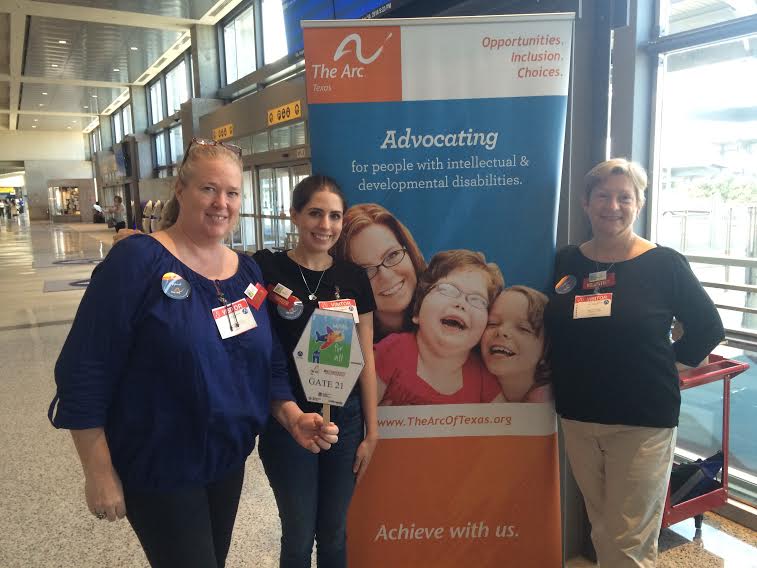 (From left) Joyce Fossmeyer, Kristina Ferguson and Mary Alice Jackson at the airport.
(From left) Joyce Fossmeyer, Kristina Ferguson and Mary Alice Jackson at the airport.It was a Saturday afternoon in early September when my staff and I arrived at the Austin-Bergstrom International Airport to participate in “Wings for All,” an opportunity for children with autism and other developmental disabilities to practice navigating an airport. Air travel has become increasingly stressful, and for youngsters with sensory issues and other special needs, it can seem overwhelming. The purpose of the program is to ease the experience for families and to educate airport personnel on the needs of these travelers.
The day’s activities were organized by The Arc of the Capital Area, The Arc of Texas, the Autism Society of Central Texas, Austin-Bergstrom International Airport, American Airlines and TSA. They were conducted under the auspices of a nationwide program─Wings for Autism─which is administered by The Arc of the U.S. and partially sponsored by the Special Needs Alliance. Similar events are being hosted throughout the U.S. by local chapters of The Arc. The airport specifically selected Saturday afternoon for the program because of the low traffic volume.
Kristina Ferguson, my law clerk, appreciated the training volunteers received ahead of time. We watched a video that began with the history of Wings for Autism, then covered behaviors associated with autism and intellectual disabilities, as well as typical issues faced by children and their families when visiting an airport.
Thirty volunteers helped 75 family members make their way from ticket counters through TSA scanners, past departure gates, and, finally, to a plane. They learned about checking bags, taking off their shoes for security inspection and waiting for their “flight.” They met the pilot, visited the cockpit, saw the bathrooms, put on their seat belts and listened to the flight attendant’s instructions. Some of them retrieved checked belongings at the luggage carousel.
Joyce Fossmeyer, my legal secretary, formerly taught high schoolers with autism, and her experience was invaluable. She knew how to ease a nervous child’s anxiety and could speak knowledgeably with parents.
The Austin airport is visually arresting, with a bandstand and lots of pictures. As the kids arrived, their faces were full of wonder.
These parents had never traveled by air with their kids before and were clearly concerned about how it would work out. The day’s experiences gave them a real way to gauge readiness and compare notes with other families. “Now we know we can do this,” said one, while another admitted, “He’s just not ready yet.”
One nine-year-old boy, who was practicing for a trip to see him grandmother, was thrilled by everything he saw. Convinced that he and his mom were actually on their way, he was the last to deplane. “I think he’s finally resigned to waiting,” said his mom as they reached the terminal exit. Now he knows what he has to look forward to.
We had a great time representing SNA, and it was thrilling to see the happy looks on the faces of kids and parents as they said goodbye.
About this Article: We hope you find this article informative, but it is not legal advice. You should consult your own attorney, who can review your specific situation and account for variations in state law and local practices. Laws and regulations are constantly changing, so the longer it has been since an article was written, the greater the likelihood that the article might be out of date. SNA members focus on this complex, evolving area of law. To locate a member in your state, visit Find an Attorney.
Requirements for Reproducing this Article: The above article may be reprinted only if it appears unmodified, including both the author description above the title and the “About this Article” paragraph immediately following the article, accompanied by the following statement: “Reprinted with permission of the Special Needs Alliance – www.specialneedsalliance.org

Leave A Comment
You must be logged in to post a comment.